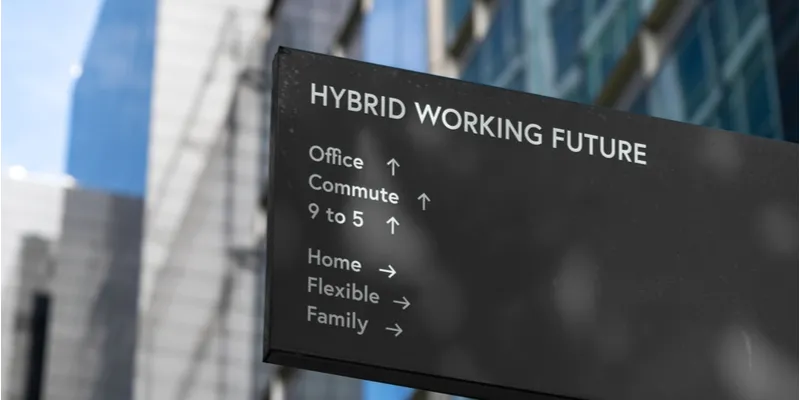What is the future of work looking like for women as we move into 2022?
With the pandemic still raging on, will 2022 see an increased representation of women in the workforce, flexible working options, holistic opportunities for growth and gender equity? Women from different domains list out their expectations on the future of work.
Almost a year into the pandemic, in January last year, YourStory’s Future of Work conference deliberated on whether the new normal has empowered the women workforce and helped them seamlessly divide their time between work and home.

The discussion threw up some interesting insights.
Anuradha Kalakat, Head of Product Innovation, , echoed a common sentiment. “The biggest lesson that all of us have learnt in the past year is that we aren’t tied to a location to get our work done or run our companies. Organisations have been able to trust their employees and provide a more output-based evaluation rather than a face-time based one.”
Visakha Vaidya, Engineering Manager, Atlassian, believed that the new normal of working has definitely opened a number of opportunities to many women, especially those who are not a part of the workforce because of other family commitments. “It’s now easy for women to work from the comfort of their homes, without having to uproot their lives,” she said.
However, with the COVID-19 pandemic showing no signs of abating, all is not hunky-dory.
A July 2020 McKinsey study found that female job loss rates due to COVID-19 have been about 1.8 times higher than male job loss rates globally. Meanwhile, an ILO report from July 2021 forecast that by the end of the year, there would be 13 million fewer women at work globally, while men’s employment will begin to recover to 2019 levels.
And despite the benefits of working from home, a study actually revealed that as much as 68.5 percent out of 3,200 women surveyed hoped to return to the workplace, just like the pre-pandemic times.
On the other hand, as workplaces adopted a hybrid working environment, JobsForHer reported a 40 percent rise in the number of career opportunities available for women on its platform in the past one year.
What will 2022 augur for working women as we continue battling new variants of the virus? How are they planning to cope with extended periods of working from home?
What will the future of work look like? HerStory spoke to a number of women from different domains to understand their expectations on the “future of work” as we move into 2022.
Investing in meaningful development opportunities
The pandemic served as both an accelerator of change for increased representation of women in senior leadership and executive positions, and also as a notable reminder of certain barriers to the participation of women in the workforce. When we look at the future of work, we should look towards investing in meaningful development opportunities to ensure that a hybrid working environment is created, which allows women to thrive. However, there still exists stereotyping at some levels on what women can do. Spiral thinking by all, including women, becomes more important.
Technology has played a huge role in shaping the workplace for women and will continue to do so as we move into 2022. More and more women are leveraging technology to spur action through activism, future-proof their careers with the right tools and skills and also choose entrepreneurship to launch their own businesses.
Srikripa Srinivasan, Vice President, Performance Analytics Group - Dell Technologies
Make time for yourself
Going into the new year, I believe work from home and flexibility due to the pandemic is likely to continue. Over the last two years, this has helped both men and women manage personal, work and family commitments, though yes, it has its own challenges.
The pandemic has been overwhelming, but one thing I can say is that in the middle of juggling remote working, balancing work and home life, etc., take out time for yourselves to rejuvenate mentally. Whether through meditation or exercise, keeping an hour to yourself during the day will help you recharge. I practice affirmations and have inculcated gratitude in my routine to help me re-focus on my goals.
Swati Bhargava, Co-founder - ,
Using tech to promote work-life balance
One of the most important factors that will influence the prevalence of different work models for different companies will be the status of the pandemic in the relevant place. Therefore, not one model will fit all.
One thing is very clear - hybrid working along with remote working is the way forward, where possible. Employers will have the added burden of managing in-person work and remote work. Coordinating hybrid working models is the need of the hour to ensure that all employees will get some days in office and some remote work days, to ensure inclusion and eliminate any employee biases.
In 2022, remote work will no longer be uncharted waters. It will act as a safe-guard against any crisis that may crop up in the future, although it does come with its own set of challenges for both employers and employees. Employers have to not only find a way to let people work from their place of choice, but will have to provide some amount of flexibility when it comes to working hours as well.
Another important factor that will influence the future of work will be promoting a work life balance and using technology to help employees achieve that. In 2022, employers will have to offer more in terms of flexibility, care for mental health and elevate their health care plans.
Divyata Shergill, Founder - Shaadi Wish
Invest in flexible work options
The future of work will continue to be hybrid with significant uncertainties regarding the pandemic. This could be a blessing and a curse for women as they juggle the numerous facets of care for the family while also showing up for work in their best faculties. Work from home could be a blessing due to the time saved on travel and spending more time with loved ones. On the other hand, this could be more stressful for some women, especially if they have children while also tending to daily household routines.
Women have traditionally been working on several shifts as they took care of work and home. Women are stated to contribute at least three times more than men towards household work and caregiving. With limited possibilities of reliance on support infrastructure, including schools and day-care, all shifts are now combined into one, and several women may find this very stressful. To help with diversity and encourage better women participation at work, enterprises will continue to invest in providing flexible working options coupled with an entrepreneurial culture that offers more freedom while keeping a close eye on delivering outcomes.
Srividya Kannan, Founder Director –
Work on restoring gender equity
The COVID-19 pandemic has seen a confluence of events for many women—namely an increase in their workloads at work and responsibilities at home. Many women are leaving the workforce due to being burnt out. With the pandemic showing no signs of giving up, 2022 will be the first year of the transition to more hybrid, less full-time working from the office.
This is a critical moment for employers to understand what women need - and to start working to restore gender equity within their organisations. Companies need to provide an inclusive work culture where women are more confident about reporting non inclusive behaviours and feel supported by their employers on work-life balance. This leads to sounder mental health, motivation, and productivity for the women workforce, and they are better positioned to cope with any greater challenges coming their way.
Swetha Harikrishnan, HR Director -

Ecosystems conducive to holistic growth
The future of work for women is positive and everybody has a role to play – in organisations, allies, mentors, government, and women themselves. There are three factors that can positively influence the future of work for women:
New ways of working
New ways of working such as hybrid working models will continue to be critical to augment career possibilities for women. These models will offer flexibility for those who need it even as we eventually move past the pandemic.
Focus on holistic development
In 2022 and beyond, we’ll also see more organisations create ecosystems that are conducive to holistic growth. The task cannot stop at simply recruiting the best talent, it can continue by nurturing careers of women employees through continuous growth and learning opportunities, talent mobility, mentoring and networking. Women also need to make their growth a priority and ensure they are leveraging these opportunities.
Return to work inclusions
More organisations will also realise the potential of bringing women back into the workforce as they expand their talent acquisition strategies to include hiring women who have taken career breaks for personal reasons such as childcare. At Fiserv we curate career opportunities through our ‘Forward For Her’ program that focuses on bringing women tech enthusiasts back to the workforce. This is a massive untapped talent pool that can truly make organisations more inclusive.
Ritu Thareja, Vice President, Software Development -
Hybrid is the new way to work
The pandemic has been especially tough on women, who have had to juggle things on many fronts, both in terms of work as well as in personal life. With the pandemic still around and new variants threatening return to normalcy, this situation will probably continue. For corporate India, hybrid is the new way to work. But that is a double-edged sword. On the one hand, it means women get the flexibility they need, and on the other hand, if they choose that, it puts them at a slight disadvantage vis-à-vis those in office. The only way forward is to for organisations to make hybrid more seamless and equitable. And for women to make sure that they take advantage of the growth opportunities they get, especially through learning and development programmes.
Deepshikha Dharmaraj, Chief Executive Officer - BCW India Group
Reconfiguration of workplace inevitable
Let’s accept that the effects of the pandemic are likely to linger on well into the next five years. A more flexible working environment that will accommodate more women in its wings is set to emerge.
Research data says that most meetings will be conducted only by email and IM and office buildings could become nothing but elaborate conference centres. The standard 9-to-5 office hours will become a thing of the past and home office stipends and home medical insurances will become common incentive.
With remote automation becoming more accelerated, a reconfiguration of the workforce will become inevitable. An evolved organisation will naturally become flexible in their efforts to prioritise sales and services to its clients and thus will lead the way in employing more women in their work force.
Radhika Iyer, Entrepreneur, Yogini, Mountaineer & Philanthropist
The show must go on
Covid is here to stay for a while, but we cannot let it rule our lives. As long as we stay smart and cautious, we have to get on with our lives. For women, workforce participation numbers look terrible, it’s down from 37 percent to 27 percent pre Covid and 20 percent post Covid. This must change and companies need to do a lot more to attract talent. I was recently a judge on Shark Tank and it was wonderful to see that 49 percent ventures that got funded had women co-founders !
Women had a heavy domestic burden during the pandemic which isn’t the case anymore with the house help situation back to normal but the challenges of online education of kids continue. However we have all found creative ways to deal with that. So the bottom line is - the show must go on. Get back to the workforce and get on with life.
Namita Thapar, Executive Director –
Exercise precaution to avoid unconscious biases
Organisations will morph into responsive workplaces where roles and structures are aligned to outcomes, thus increasing agility. Diversity leaders will have a bigger involvement in role design as well as creative agile work systems so that employees across all backgrounds and their needs are factored when the organisation is redesigning their new blueprint. This will also enable cross-functional knowledge and training, leading to a more diverse and empowered workforce.
In the post pandemic world, most organisations will expand policies, programmes, and cultures that explicitly support women in the workplace. These organisations will see the impact of this through increased engagement, productivity, and loyalty. However, the future of work being hybrid, there’s a tendency to extend permanent remote work to women in view of schools and day-care centres remaining shut. Despite being an empathetic gesture, this can lead to fewer women taking up leadership roles and eventually creating a gender gap at management levels. Organisations must exercise precaution to avoid any such unconscious biases.
Smitha Hemmigae, Head of Marketing - ANSR
A work system for women to thrive equitably
Starting with self-empowerment, we have all been making choices to better adapt to the new norm based on our comfort and priorities, ensuring the wellbeing of self and our families. As we continue to integrate work and personal lives, women will continue to juggle competing priorities. It will be crucial to continue providing flexible working arrangements, further support through tailored skill development workshops, coaching and helping them develop networks to ensure steady advancement in their careers.
The second notable aspect is for organisations to continue providing a work ecosystem that enables women to thrive equitably. Smooth integration of work and personal lives continues to be the highlight of how we set the foundation for building efficient hybrid models. We need to place greater emphasis on connectedness and collaboration, and at the same time recognize that working remotely allows us ample flexibility to accommodate responsibilities at home while still impactfully contributing towards the growth of the firm. A critical aspect that will underscore the success of hybrid models is to embed empathetic leadership in the DNA of the firms, building and sharing best practices to manage the new ways of working and learning from each other.
The last, and often overlooked, factor relates to the personal support group for all of us, especially women. In the past two years, we have learned so much about integrating our two worlds that we must continue to apply those learnings as we adapt to the new norm. So, we should keep involving families and displaying everyday accomplishments to instill a sense of pride in them about the everyday wins of women.
Apoorva Aggarwal, Office Managing Principal, New Delhi - ZS India
Edited by Anju Narayanan




![[Year in Review 2021] Top five women in technology who continue to inspire us](https://images.yourstory.com/cs/4/8e7cc4102d6c11e9aa979329348d4c3e/women-in-tech1-1640666175867.png?fm=png&auto=format&h=100&w=100&crop=entropy&fit=crop)





